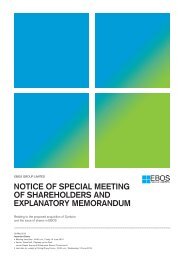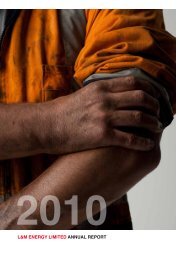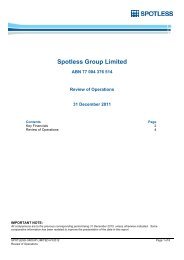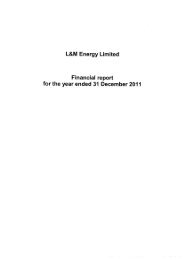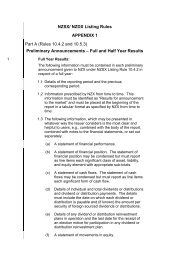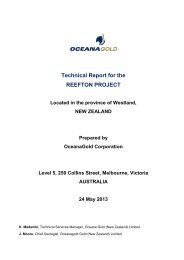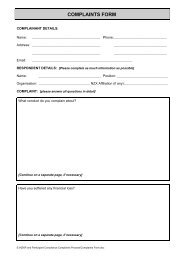Westpac Group Pillar 3 Report March 2013 - Iguana IR Sites
Westpac Group Pillar 3 Report March 2013 - Iguana IR Sites
Westpac Group Pillar 3 Report March 2013 - Iguana IR Sites
You also want an ePaper? Increase the reach of your titles
YUMPU automatically turns print PDFs into web optimized ePapers that Google loves.
PILLAR 3 REPORT<br />
EXECUTIVE SUMMARY<br />
Basel III transition impacts<br />
On 1 January <strong>2013</strong>, Australian Prudential Regulation Authority’s (APRA) new prudential standards for capital<br />
came into effect. These standards adopt the Basel Committee on Banking Supervision (BCBS) reforms,<br />
commonly known as Basel III, to the Australian financial system. APRA has applied national discretions under the<br />
framework and, as such, capital ratios calculated under APRA’s standards are not directly comparable to those<br />
calculated under BCBS standards. The table below includes pro forma 30 September 2012 ratios which have<br />
been adjusted for the estimated impact of the Basel III changes.<br />
Basel III<br />
Basel III Pro Forma Basel 2.5<br />
% 31 <strong>March</strong> <strong>2013</strong> 30 September 2012 30 September 2012<br />
The <strong>Westpac</strong> <strong>Group</strong> at Level 2<br />
Common Equity Tier 1 ratio 8.7 8.2 8.4<br />
Additional Tier 1 capital 2.1 1.6 1.9<br />
Tier 2 capital 1.7 1.7 1.4<br />
Total regulatory capital ratio 12.5 11.5 11.7<br />
In transitioning to APRA’s Basel III standards the following significant changes to the calculation of capital ratios<br />
have occurred:<br />
Capital Deductions - Investments in wealth and insurance subsidiaries, and regulatory expected loss<br />
adjustments 1 , both previously deducted from Tier 1 and Tier 2 capital on a 50/50 basis; and equity investments,<br />
previously subject to thresholds, are now 100% deductions against common equity;<br />
Dividend Payments - Expected dividend payments, previously deducted from capital on an accrual basis, are<br />
now deducted when declared;<br />
Risk Weighted Assets (RWA) - Two changes to the measurement of RWA were implemented: a new charge for<br />
the risk of mark-to-market losses when the credit quality of a derivative counterparty is downgraded; and an<br />
increased RWA factor for exposure to financial institutions reflecting a changed regulatory view on the degree of<br />
correlation among these exposures under stressed conditions; and<br />
Tier 1 and Tier 2 Capital - New qualifying criteria for Tier 1 and Tier 2 capital instruments have been introduced.<br />
Instruments issued before 1 January <strong>2013</strong> are subject to a transitional arrangement that progressively reduces<br />
their contribution to regulatory capital over time.<br />
Basel III<br />
Basel III Pro Forma Basel 2.5<br />
Risk Weighted Assets ($m) 31 <strong>March</strong> <strong>2013</strong> 30 September 2012 30 September 2012<br />
Credit risk 253,734 257,014 245,099<br />
Market risk 10,555 12,087 12,087<br />
Operational risk 26,761 26,757 26,757<br />
Interest rate risk in the banking book 13,744 10,234 10,234<br />
Equity risk - - 1,263<br />
Other 3,182 2,461 2,461<br />
Total 307,976 308,553 297,901<br />
Changes in risk weighted assets<br />
Basel III pro forma adjustments added $10.7 billion to reported RWA for 30 September 2012, with a $12.0 billion<br />
increase in credit RWA partially offset by the removal of $1.3 billion RWA for equity risk. Equity risk continues to be<br />
incorporated when determining capital ratios although equity investments are now treated as a 100% deduction<br />
from capital rather than represented as RWA. Allowing for this adjustment, <strong>Westpac</strong>’s RWA have remained<br />
relatively flat between 30 September 2012 ($308.6 billion) and 31 <strong>March</strong> <strong>2013</strong> ($308.0 billion).<br />
Excluding the Basel III transitional impact, movements in RWA included:<br />
Credit risk RWA declined 1% or $3.3 billion. Lower business lending RWA mostly reflecting the benefit of<br />
reduced stressed assets, more than offset growth in RWA in Australian mortgages;<br />
Interest rate risk in the banking book (<strong>IR</strong>RBB) increased $3.5 billion reflecting a smaller embedded gain and<br />
slightly increased risk exposure;<br />
Lower market risk RWA of $1.5 billion from a reduced exposure to interest rate risk; and<br />
1 Deferred tax assets (DTA) previously included in the deductions for regulatory expected loss are now reported within the common equity Tier 1<br />
deductions for DTA.<br />
3



